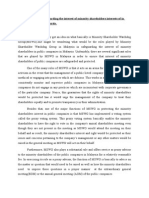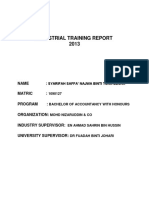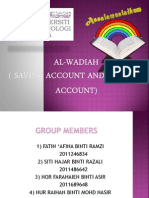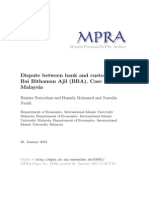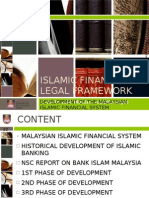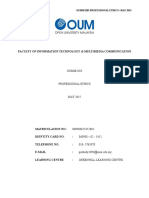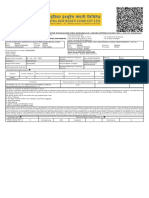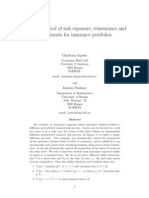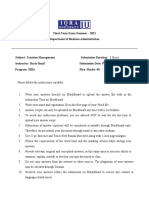100%(1)100% found this document useful (1 vote)
165 viewsTakaful Review
Takaful Review
Uploaded by
Farhain SarminThis document summarizes a research article about risk management in the takaful (Islamic insurance) industry. It discusses the risks faced by takaful operators, including business, financial, operational and Shariah compliance risks. The authors used secondary data analysis to study how takaful companies classify and manage these risks. Effective risk management is important for protecting the takaful fund and ensuring it can pay out claims. Regulators in Malaysia have implemented guidelines and oversight to help takaful firms strengthen their risk frameworks and ensure Shariah compliance.
Copyright:
© All Rights Reserved
Available Formats
Download as DOCX, PDF, TXT or read online from Scribd
Takaful Review
Takaful Review
Uploaded by
Farhain Sarmin100%(1)100% found this document useful (1 vote)
165 views10 pagesThis document summarizes a research article about risk management in the takaful (Islamic insurance) industry. It discusses the risks faced by takaful operators, including business, financial, operational and Shariah compliance risks. The authors used secondary data analysis to study how takaful companies classify and manage these risks. Effective risk management is important for protecting the takaful fund and ensuring it can pay out claims. Regulators in Malaysia have implemented guidelines and oversight to help takaful firms strengthen their risk frameworks and ensure Shariah compliance.
Original Description:
takaful issues
Copyright
© © All Rights Reserved
Available Formats
DOCX, PDF, TXT or read online from Scribd
Share this document
Did you find this document useful?
Is this content inappropriate?
This document summarizes a research article about risk management in the takaful (Islamic insurance) industry. It discusses the risks faced by takaful operators, including business, financial, operational and Shariah compliance risks. The authors used secondary data analysis to study how takaful companies classify and manage these risks. Effective risk management is important for protecting the takaful fund and ensuring it can pay out claims. Regulators in Malaysia have implemented guidelines and oversight to help takaful firms strengthen their risk frameworks and ensure Shariah compliance.
Copyright:
© All Rights Reserved
Available Formats
Download as DOCX, PDF, TXT or read online from Scribd
Download as docx, pdf, or txt
100%(1)100% found this document useful (1 vote)
165 views10 pagesTakaful Review
Takaful Review
Uploaded by
Farhain SarminThis document summarizes a research article about risk management in the takaful (Islamic insurance) industry. It discusses the risks faced by takaful operators, including business, financial, operational and Shariah compliance risks. The authors used secondary data analysis to study how takaful companies classify and manage these risks. Effective risk management is important for protecting the takaful fund and ensuring it can pay out claims. Regulators in Malaysia have implemented guidelines and oversight to help takaful firms strengthen their risk frameworks and ensure Shariah compliance.
Copyright:
© All Rights Reserved
Available Formats
Download as DOCX, PDF, TXT or read online from Scribd
Download as docx, pdf, or txt
You are on page 1of 10
Mohammad Kamil bin Abu Talib, Nooraslinda abdul Aris and Roszana Tapsir (2012)
Risk and Management of Takaful Industry. Journal of Global and Economics,
Volume 4, Number 1(page: 29-39)
The article of Risk and Management of Takaful Industry by Mohammad Kamil bin Abu
Talib, Nooraslinda abdul Aris and Roszana Tapsir that appeared in journal of global and
economics can be said to be an argument about risk management that is important in Islam
which takaful provides a way to manage risks in business according to Shariah principles.
The argument will be developed through a critical review of their paper, discussing in turn its
conceptual bases, research methods, main findings and practical implications.
Kamil, Nooraslinda and Roszana made some clarification about risk of takaful company and
identifies the management of such risk by the takaful operator. Proper planning, control,
implementation and monitoring must be put in place to ensure the society interest is well
safeguard. The justice must exist for the benefit of the society as being commanded under the
maqasid shariah. The category of risk profile for Islamic finance have two which are generic
risks and unique risk. Islamic finance with its unique characteristics give rise to a set of risk
management challenges namely credit risk, liquidity risk, legal and fiduciary risk, financial
supervision and transparency and shariah supervision risk (Morisano 2009). Due to the rapid
growth in Islamic finance, there is a need for a unique risk framework for Islamic institutions,
particularly for takaful operators. The compliance of Shariah should have directs relationship
with the management of risks since the unique risk for Islamic institution lies in the shariah
supervision risk.
The research method is by secondary analysis when an analyse data which was collected by
another researcher. It allows the researcher to explore areas of interest without having to go
through the process of collecting data themselves in the field. The study utilised a survey
research strategy to understand about risk management essential for takaful company. The
research findings of risk management are to protect the safety of the takaful fund, to ensure
the fund is able to pay claims and obligations, to achieve a required rate of return on
investment if possible, ability to withstand and adverse conditions and to ensure continuity as
a going concern. Then, most of the takaful operators classified their risks into three headings
namely the takaful (business) risk, financial risk and operational risk. Identifying and
classifying the risk in takaful business is important as it will enable them to manage the risk
more effectively.
The articles first outlines is the meaning of takaful which derives from word kafalah
(guaranteeing each other or joint guarantee). In principle, Takaful system is based on mutual
co-operation, responsibility, assurance, protection and assistance between groups of
participants. It is a form of mutual insurance (S. Saaty & Ahmad Ansari, 2009). The central
idea of a Takaful contract is that it is a financial transaction of a mutual co-operation between
two parties to protect anyone of them from unexpected future material risk. In a Takaful
transaction, the participant (insured) pays a particular amount of money known as the
contribution (premium) to the Takaful operator (insurer) with a mutual agreement that the
insurer is under a legal responsibility to provide the participant with a financial protection
against unexpected loss, should it happen within the agreed period. However, in a case where
the loss does not occur against the insured within the specified period, the insured is entitled
for the whole amount of paid-premiums together with the share of profits made out of the
cumulated paid-premiums based on the principle of Mudharabah (profit sharing) financing
technique. In such a transaction, both the insurer and the insured are mutually helping each
other for financial protection (Khan, 2003).
Next, the article emphasized about the risk. Risk is the probability that a chosen action will
lead to a loss or undesirable outcome. Risk is also defined as uncertain future events which
could influence the achievement of the businesss objectives, including strategic, operational,
financial and compliance objectives. Potential losses themselves may also be called risks.
Any human endeavour and business carries some risk, but some are much riskier than others.
In a nutshell, risk denotes losses. The concept of risk has been associated with uncertainty of
events in future. The higher the uncertainty of events, the higher the risk. Shariah non-
compliance risk is the risk arising from failure to comply with shariah rules and principles as
determined by the shariah regulatory council. In Malaysia, the highest authority of shariah
lies with the national shariah advisory council of the Central Bank of Malaysia (Bank
Negara Malaysia or BNM) and the Security Commission. Shariah non-compliance risk is
considered paramount as it is the distinguishing factor between the Islamic and conventional
systems.
Islamic Financial Service Board (IFSB) classifies risk into six categories namely operational
risk, credit risk, equity investment risk, market risk, liquidity risk and rate of return risk.
Operational risk is defined as risk of losses resulting from inadequate of failed internal
process, people and system or from external events, which include legal risk and shariah
compliance risk, but exclude strategic and operational risk (IFSB, 2004). The shariah
compliance risk cuts across the six categories of risk and is considered as part of the
operational risk. Therefore, shariah compliance is an important feature in an Islamic
financial institution. The scope of shariah compliance includes includes the takaful model
(mudharabah, wakalah or hybrid), takaful products, investments, contract wordings,
marketing collateral, surplus sharing and fee structures.
One of the aspects under shariah compliance is to ensure acceptance, validity and
enforceability of contract according to the shariah law. Breeching any shariah element in a
contract will result in severe implications, both financial and non-financial. From financial
perspective, the contract may be invalid and result in obtaining illegal profit from such
transaction. Non-financial impacts include impediment from ALLAHs barakah (blessing),
against the command of ALLAH, contravening the provision of legislations (Takaful Act
1984 and Islamic Banking Act 1983) and jeopardising the reputation of the IFI. Thus, the
concpet of ibadah as promoted in islam will not materialise. This shows that shariah
noncompliance is a real risk which may lead to serious losses for the takaful operator.
The article showed that in Malaysia, the IFIs are guided by their internal Shariah
Supervisory Board which are established to advise and ensure their products comply and
adhere to the Shariah principles. This is a requirement by BNM to all IFIs including takaful
companies. To oversee the institutions compliance (products, services and operations), BNM
also has a Shariah Advisory Coucil (SAC). BNM is continuously enhancing the Shariah
framework to be in line with the developments in the takaful industry. This is crucial to
ensure uniformity of Shariah interpretations in its effort to strengthen the regulatory
framework of the Islamic finance industry. The strong Shariah framework enhances
consumer confidence and gives greater flexibility for takaful operators to be innovative
within the boundary of Shariah (BNM, 2005).
Besides, the article said that managing risk involves creating awareness of uncertainty,
qualifying the risks, managing the controllable risks, and minimizing the impact of
uncontrollable risks by risk allocation/apportionment. Ineffective risk management is often
caused by lack of formalized risk management procedures, including risk identification,
analysis and control (Tah and Carr, 2001); lack of continuity of risk management in the
different stages in the project life cycle; poor integration between risk management and other
key processes; and a lack of interaction among different parties. Risk management in takaful
industry is a process to identify potential losses of an operator and to select the most
appropriate techniques for treating such potential losses. To ensure the effectiveness of
overall management, takaful operators are required to observe the Guidelines on Directorship
for Takaful Operators, which govern the appointment of directors and chief executives and
the setting up of board committees, including risk management committee. In addition,
takaful operators are also required to observe prudential limits and conditions imposed on the
outsourcing of the management of takaful funds so as to ensure that the funds are properly
managed within the accepted risk management framework (BNM, 2005).
As conclusion, in line with shariah requirements and the concept of takaful, risk
management practice and management of a takaful operator should be better off than a
conventional insurance operator. Protection that is in accordance with maqasid shariah needs
to be integrated into the Islamic finance activities. Takaful operators need to be proactive in
managing their risks as part of good governance and best practice code. Self-regulatory is
needed rather than depending on regulatory requirements. As risk is an on-going process,
continuous development of knowledge is required in order to understand and manage the
risks effectively. Irrespective of the business model adopted by the takaful operators
(mudharabah or wakalah or hybrid), the risk management will be the same since the basis is
shariah.
REFERENCE
1. Abd Rahman, Z. (2010). Contracts & The Products of Islamic Banking. Kuala
Lumpur: CERT Publications Sdn Bhd.
2. Abdul Aris, N., & Othman, R. (2011). Takaful Industry: A Malaysian Experience.
Shah Alam: Universiti Teknologi MARA.
3. Abu-Tapanjeh, A. M. (2009). Corporate Governance from the Islamic Perspective: A
Comparative Analysis with OECD Principles. Critical Perspectives on Accounting 20,
556-567.
4. Ahmad K. (2000). Islamic finance and banking: the challenge and prospects. Review
of Islamic Economic 2000; 9:5782.
5. Ahmad, M. (1967, June 6). Semantic of Theory of Interest. Islamic Studies
(Rawalpindi) , 171-196.
6. Ahmed, P. (2010, April 12 & 13). Risk Management in Takaful: What Makes the
Differences? Fifth Annual World Takaful Conference . Dubai, UAE.
7. Abdul Majid, M. Z. (2009). "Pentakrifan Semula Konsep Pematuhan Syariah dalam
Urusan Perbankan Islam." In Visi.
8. Asyraf W. D. (2006). Stakeholders expectation toward corporate social responsibility
of Islamic Banks. In: IIUM International Accounting Conference (INTAC) III.
Salder Jaffer, Farzana Ismail, Jabran Noor and Lindsay Unwin (2010) Takaful
(Islamic Insurance): Concept, Challenges and Opportunities. Milliam Research
Report.
The research report by Salder Jaffer, Farzana Ismail, Jabran Noor and Lindsay Unwin that
appeared in Milliam research report stated about principles and practices underlying takaful,
issues and challenges facing the takaful industry and the takaful operating models. The
argument will be developed through a critical review of their paper, discussing in turn its
conceptual bases, research methods, main findings and practical implications.
The research first stated about the background and market outlook of takaful which whilst
takaful started in 1979 in Sudan, and it only gained momentum in early 2000 when the
Malaysian government promoted it and significant growth was witnessed thereafter. Next the
research emphasized about principles and practices underlying takaful. Three elements that
prohibited in takaful are riba, maisir and gharar. The research paper also make comparison
between conventional insurance and takaful. The authors also make some clarification about
takaful operating model which are mudharabah model and wakala model. Some issues and
challenges facing the takaful industry in following section such as key issues and challenges
and technical issues and challenges.
The research method is by
The articles first outlines is described about principles and practices underlying takaful.
There are certain key issues within conventional insurance that Islam does not permit which
are riba, maisir, gharar and forbidden things. There is a further focus in takaful around the
importance of moral values and ethics as business meant to be conducted openly in
accordance with the utmost good faith, honesty, full disclosure, truthfulness and fairness in
all dealings. The pooling does eliminate Gharar, as the uncertainty about the future claims
events certaintly still exists but now is acceptable as the donation (tabarru) is meant for
mutual assistance and not for profit-taking or gambling. The article also make comparison
between conventional insurance and takaful such as conventional insurance contains three
element while takaful does not contain three element of it. In conventional insurance profit
belongs to shareholder and the with-profit policyholders. The insurer is covered during the
policy period but is not entitled to any return at end of such period. While in takaful, surplus
belongs to the participants and is accordingly returned to them.
The components and current practices in the takaful industry such as family takaful and
general takaful, Shariah-compliant assets, retakaful and retro-takaful. Family takaful
offerings provide access to life coverage in a manner which does not conflict with their
religious belief. Family takaful is designed to combine protection for the benefit of ones
dependents with a savings element and requires the distribution of surplus to participant.
Shariah-compliant asset is the avoidance of Riba, Gharar, Haram and Maisir in the design of
takaful products which has significant impact on decisions of takaful operation. On the point
of retakaful, it allows takaful fund to share risk among multiple takaful pools. Some retakaful
operators retrocede conventionally on the basic of necessity because currently there is
limited Retro-Takaful capacity available.
Next, the research emphasized on takaful operating model which are commonly structured
such as the Mudharabah model and the Wakala model. Then it found out that Mudharabah
model less acceptable globally but perhaps more attractive as profit is shared with the
policyholders. However, there is a strong opinion of scholars from especially the Middle East
that underwriting profit cannot be shared with the operator as it stem from donation. The
Wakala model is by far the most recognised and has the positive effect of providing a fixed
and steady income stream. However, in its purest form it has limited upside potential as the
only source of income is the Wakala fee. This could harm competitiveness as a high up-front
Wakala fee might look unattractive to participants and have adverse effects to new entrants
because of the high initial costs. There has been an increasing trends towards the hybrid
model which is the based on the application of the Wakala model for the underwriting portion
and the application of the Mudharabah model for the investment part. Considering that
investment income usually make up the bulk of the profits, this model is viewed by many
Takaful operators to be commercially viable. The AAOIFI has also endorsed hybrid versions
of Wakala model.
Besides, the authors also found out the issue and challenges facing the takaful industry
nowadays are lack of consumer awareness, scarcity of human resources with both insurance
and Shariah expertise, the shortage of Shariah scholars with appropriate experience, lack of
standardisation in the industry that is due to Shariah interpretation, solvency and capital
requirements, corporate governance and shortage of suitable assets. In addition, there are
various technical issues within the Takaful industry, which may be relevant in the valuation
and risk management of takaful business. Some of the key technical issues considered are
treatment of the interest-free loan (Qard Hasan), approach to underwriting and claim
management, determination and distribution of surplus, treatment of contingency reserves,
treatment of participants pools, issues around Retakaful and retrocession and treatment of
transfers of in-force business from conventional reinsurer to Retakaful.
REFERENCE
1. Wong, K. (2007). Risk-based capital framework for insurers in Malaysia
2. Bank Negara Malaysia. Guidelines on Takaful operational framework. Concept paper.
3. Ernst & Young (2008, 2009). World Takaful Report.
4. Usmani, Muhammad Taqi (2007). Introduction to Islamic Finance
You might also like
- Agreement For Chairman of Board of DirectorsDocument8 pagesAgreement For Chairman of Board of DirectorsShatir LaundaNo ratings yet
- Travel Insurance PolicyDocument2 pagesTravel Insurance PolicyImissyouLove CombakNo ratings yet
- Principle of DhararDocument21 pagesPrinciple of DhararMahyuddin KhalidNo ratings yet
- Role of MSWG in Safeguarding The Interest of Minority Shareholders Interests of in Public Companies in MalaysiaDocument3 pagesRole of MSWG in Safeguarding The Interest of Minority Shareholders Interests of in Public Companies in MalaysiaRita Lakhsmi100% (2)
- Halal Law and Regulations - Assignment 1Document3 pagesHalal Law and Regulations - Assignment 1Nasra Naturhana100% (1)
- Shariah Issues in TakafulDocument16 pagesShariah Issues in Takafulfashdeen100% (2)
- HIBAH APPLICATION IN MALAYSIA NewDocument4 pagesHIBAH APPLICATION IN MALAYSIA NewJoey TanNo ratings yet
- Pengukuhan Nilai Dan Prof Penjawat Awam Malaysia PDFDocument34 pagesPengukuhan Nilai Dan Prof Penjawat Awam Malaysia PDFAhmad Fkrudin Mohamed Yusoff100% (1)
- Positioning Malaysia in the International Arena: Perdana Discourse Series 5From EverandPositioning Malaysia in the International Arena: Perdana Discourse Series 5No ratings yet
- OSH Reporting by Newspapers in MalaysiaDocument45 pagesOSH Reporting by Newspapers in Malaysiaahmadnaimzaid100% (3)
- Green Building Toward Construction Sustainability: Energy Efficiency With Material and Design AspectsDocument11 pagesGreen Building Toward Construction Sustainability: Energy Efficiency With Material and Design AspectsghchgNo ratings yet
- Final Report 2013Document22 pagesFinal Report 2013Ahmad HazaziNo ratings yet
- Ctu 351Document19 pagesCtu 351afinaramziNo ratings yet
- Report LI NisaDocument38 pagesReport LI NisaLimau Kasturi100% (1)
- International Journal of Information Management: Boonyarat Phadermrod, Richard M. Crowder, Gary B. WillsDocument10 pagesInternational Journal of Information Management: Boonyarat Phadermrod, Richard M. Crowder, Gary B. WillsgilangNo ratings yet
- Cmi Illegal Immigrants in MalaysiaDocument11 pagesCmi Illegal Immigrants in MalaysiaKadhiraven SamynathanNo ratings yet
- Dispute Between Bank and CustomerDocument18 pagesDispute Between Bank and CustomergivamathanNo ratings yet
- Wadi'ahDocument10 pagesWadi'ahAdnan KhanNo ratings yet
- IMU200 Article ReviewDocument16 pagesIMU200 Article Reviewjannah fadhilahNo ratings yet
- Concept, Principles and Models of TakafulDocument30 pagesConcept, Principles and Models of Takafulchao yang100% (1)
- Outline Speech Importance of Sleep For College StudentsDocument10 pagesOutline Speech Importance of Sleep For College StudentsNur NadhirahNo ratings yet
- The Principles of Zakat and Tax Upon The Time of RDocument10 pagesThe Principles of Zakat and Tax Upon The Time of RRANDAN SADIQNo ratings yet
- Example FypDocument30 pagesExample Fypnashra jan100% (1)
- Industrial Training Report Citigroup Transaction Services (M) SDN BHDDocument27 pagesIndustrial Training Report Citigroup Transaction Services (M) SDN BHDhisyamstarkNo ratings yet
- Com569 Final To Check Com569 Final To CheckDocument37 pagesCom569 Final To Check Com569 Final To CheckNURUL HAZIQAH MD BADRUL HISHAM100% (1)
- Theories of Muamalat ContractsDocument5 pagesTheories of Muamalat Contractssyifa aina0% (1)
- Islamic Pawn Broking (Ar-Rahnu)Document4 pagesIslamic Pawn Broking (Ar-Rahnu)Aimi Al-YahyaNo ratings yet
- Full Report SocietyDocument31 pagesFull Report Societysaitama 121No ratings yet
- Cyber Security Awareness Among Social Media Users: Case Study in German-Malaysian Institute (Gmi)Document17 pagesCyber Security Awareness Among Social Media Users: Case Study in German-Malaysian Institute (Gmi)Isan Yys SanNo ratings yet
- Biodata Dr. Amini Englis Nov 2012Document3 pagesBiodata Dr. Amini Englis Nov 2012Amini Amir AbdullahNo ratings yet
- PAD370 Action Taken in Public ProcurementDocument4 pagesPAD370 Action Taken in Public Procurementsyakira mustafar100% (1)
- Case Study Isc550 (Group 5)Document18 pagesCase Study Isc550 (Group 5)Nur ArfahNo ratings yet
- Impact of COVIDDocument8 pagesImpact of COVIDwater liliyNo ratings yet
- Analisa SwotDocument9 pagesAnalisa SwotIqram RoslyNo ratings yet
- Case Study 1: Impact of Covid-19 To AirAsiaDocument4 pagesCase Study 1: Impact of Covid-19 To AirAsiaAliah LeeNo ratings yet
- Sample Executive Summary - ERPDocument2 pagesSample Executive Summary - ERPMarjorie Mae CruzatNo ratings yet
- A Comparison of Takaful Model and General Takaful Products Offered by Syarikat Takaful Malaysia Am Berhad and Takaful Ikhlas General BerhadDocument18 pagesA Comparison of Takaful Model and General Takaful Products Offered by Syarikat Takaful Malaysia Am Berhad and Takaful Ikhlas General BerhadKajim SharibiNo ratings yet
- Development of The Malaysian Islamic Financial SystemDocument42 pagesDevelopment of The Malaysian Islamic Financial SystemMahyuddin KhalidNo ratings yet
- Rapport and Proffesional NurseDocument4 pagesRapport and Proffesional NursevijitajayaminiNo ratings yet
- Stat ProjectDocument4 pagesStat Projectnissan91No ratings yet
- FYP Guidelines 1Document42 pagesFYP Guidelines 1Muhammad Zamir100% (1)
- Assignment IR 4.0Document4 pagesAssignment IR 4.0Adilah DiyanahNo ratings yet
- QuestionDocument4 pagesQuestionHaziq ZulkeflyNo ratings yet
- Communication and Its ImpactDocument11 pagesCommunication and Its ImpactMuhd Noor Muhd Hamdi100% (1)
- The Implementation of Sukuk Ijarah in MalaysiaDocument67 pagesThe Implementation of Sukuk Ijarah in Malaysiaetty100% (6)
- ForumDocument4 pagesForumdaarshaan100% (2)
- Forum ScriptDocument3 pagesForum ScriptSabbyNo ratings yet
- Oumm3203 Professional EthicsDocument23 pagesOumm3203 Professional EthicsSui Khim50% (2)
- Pad 240 PDFDocument10 pagesPad 240 PDFFais Aiman MustaphaNo ratings yet
- Isus Akidah - DR Jahid Sidek)Document24 pagesIsus Akidah - DR Jahid Sidek)Md EliasNo ratings yet
- Maybank Islamic BankDocument13 pagesMaybank Islamic BankSHANo ratings yet
- The Wakala WaqfDocument7 pagesThe Wakala WaqfAhmad Saifuddin Che AbdullahNo ratings yet
- Jivitha Kandasamy (Bpsy 2110-4522) Lgse 3042 Assignment 2Document14 pagesJivitha Kandasamy (Bpsy 2110-4522) Lgse 3042 Assignment 2tracyNo ratings yet
- ELC501 - WAA (Sex Education)Document6 pagesELC501 - WAA (Sex Education)Nur Fazreena ZulkepliNo ratings yet
- Faculty of Information Technology & Multimedia CommunicationDocument12 pagesFaculty of Information Technology & Multimedia CommunicationDiLip SinghNo ratings yet
- OSHA AssignmentDocument3 pagesOSHA AssignmentJoashYenNo ratings yet
- English For Written Communication OUMH1203 Mei 2012Document14 pagesEnglish For Written Communication OUMH1203 Mei 2012Azril Mohd Romli100% (2)
- QAWAIDDocument16 pagesQAWAIDMohamad NazriNo ratings yet
- Kajang Local Plan For Sustainable DevelopmentDocument49 pagesKajang Local Plan For Sustainable DevelopmentReshmi KaurNo ratings yet
- OUMH1203 English For Written Communication: Name: Matriks Number: I/C Number: Telefon: Tutor NameDocument11 pagesOUMH1203 English For Written Communication: Name: Matriks Number: I/C Number: Telefon: Tutor NameAnonymous sWvMcLnNo ratings yet
- Political Stability & Sustainability as Key Success Factors in Developing Malaysia: Perdana Discourse Series 4From EverandPolitical Stability & Sustainability as Key Success Factors in Developing Malaysia: Perdana Discourse Series 4No ratings yet
- Risk Management in Islamic Finance An Analysis From Objectives of Shari'ah PerspectiveDocument7 pagesRisk Management in Islamic Finance An Analysis From Objectives of Shari'ah Perspectivesiti fatimahNo ratings yet
- SYLLABUSsjdwssihfTAXATION I First Sem AY 2019 2020 FinalDocument52 pagesSYLLABUSsjdwssihfTAXATION I First Sem AY 2019 2020 FinalJP Ramos DatinguinooNo ratings yet
- Two Wheeler Comprehensive Policy Through CSC: Certificate of Insurance Cum Policy ScheduleDocument3 pagesTwo Wheeler Comprehensive Policy Through CSC: Certificate of Insurance Cum Policy ScheduleDebajit BorahNo ratings yet
- MGT 507 Management of Organization Change: Topic: Greening China's Financial SystemDocument13 pagesMGT 507 Management of Organization Change: Topic: Greening China's Financial SystemAllen HanNo ratings yet
- Q3FY24 TranscriptDocument21 pagesQ3FY24 TranscriptAshu KumarNo ratings yet
- Travel Guard Brochure EngDocument8 pagesTravel Guard Brochure EngJiawen WeiNo ratings yet
- ACTION NEEDED - Policy Application - Encrypted - PDFDocument22 pagesACTION NEEDED - Policy Application - Encrypted - PDFAdella HobbsNo ratings yet
- Rejda - ch05Document28 pagesRejda - ch0529_ramesh170No ratings yet
- Thomas C. Royer vs. State of Louisiana, Department of Transportation and DevelopmentDocument30 pagesThomas C. Royer vs. State of Louisiana, Department of Transportation and DevelopmentThe Town TalkNo ratings yet
- Day 1 NBA - June 2022Document104 pagesDay 1 NBA - June 2022carynehuiniNo ratings yet
- Prem Narayan Soni 14.12.2020Document2 pagesPrem Narayan Soni 14.12.2020Subhash Chandra MalviNo ratings yet
- Project Report On BHARTI AXA Life InsuraDocument50 pagesProject Report On BHARTI AXA Life InsuraArvindSinghNo ratings yet
- IRDA Circular 2007Document7 pagesIRDA Circular 2007kannan_govinda1No ratings yet
- Insurance Syllabus and Personal Notes-FINALDocument10 pagesInsurance Syllabus and Personal Notes-FINALCrnc NavidadNo ratings yet
- Optimal Control of Risk Exposure, Reinsurance and Investments For Insurance PortfoliosDocument51 pagesOptimal Control of Risk Exposure, Reinsurance and Investments For Insurance PortfoliospostscriptNo ratings yet
- Suggestions of Core Group On Distribution Framework - 10112023Document6 pagesSuggestions of Core Group On Distribution Framework - 10112023insurancekatariaNo ratings yet
- SEGURO Redpoint CompanyDocument1 pageSEGURO Redpoint CompanyJim ShortNo ratings yet
- Benefit Illustration LIC's Amrit BaalDocument3 pagesBenefit Illustration LIC's Amrit BaalVENKATESHNo ratings yet
- 105 DepaDocument12 pages105 DepaLA M AENo ratings yet
- Starting Running Nonprofit OrganizationDocument164 pagesStarting Running Nonprofit OrganizationIsrael Niño100% (1)
- Hotel AgreementDocument32 pagesHotel Agreementteeshaa.0577mrvNo ratings yet
- TS IT FY 2023-24 Full Version 1.0Document16 pagesTS IT FY 2023-24 Full Version 1.0varshithvarma051No ratings yet
- Icici Prudential Life Insurance Co. LTD Navsari BranchDocument66 pagesIcici Prudential Life Insurance Co. LTD Navsari BranchGaurang SanghaniNo ratings yet
- Essentials of Insurance Lesson Plan Rocky 450Document3 pagesEssentials of Insurance Lesson Plan Rocky 450api-259105810No ratings yet
- Taxation Management Final ExamDocument10 pagesTaxation Management Final ExamWASEEM AKRAMNo ratings yet
- Booklet Cemap 1Document296 pagesBooklet Cemap 1alen radakNo ratings yet
- ComGI 6th Ed Ver 1.2 - Chapter 4Document38 pagesComGI 6th Ed Ver 1.2 - Chapter 4AndyNo ratings yet
- Travel Insurance ConfirmationDocument3 pagesTravel Insurance ConfirmationhariNo ratings yet
- ĐỀ THI SỐ 2: 75mins Part 1: Multiple Choices (6 Points) - Circle The Correct AnswerDocument4 pagesĐỀ THI SỐ 2: 75mins Part 1: Multiple Choices (6 Points) - Circle The Correct AnswerBích ChâuNo ratings yet



